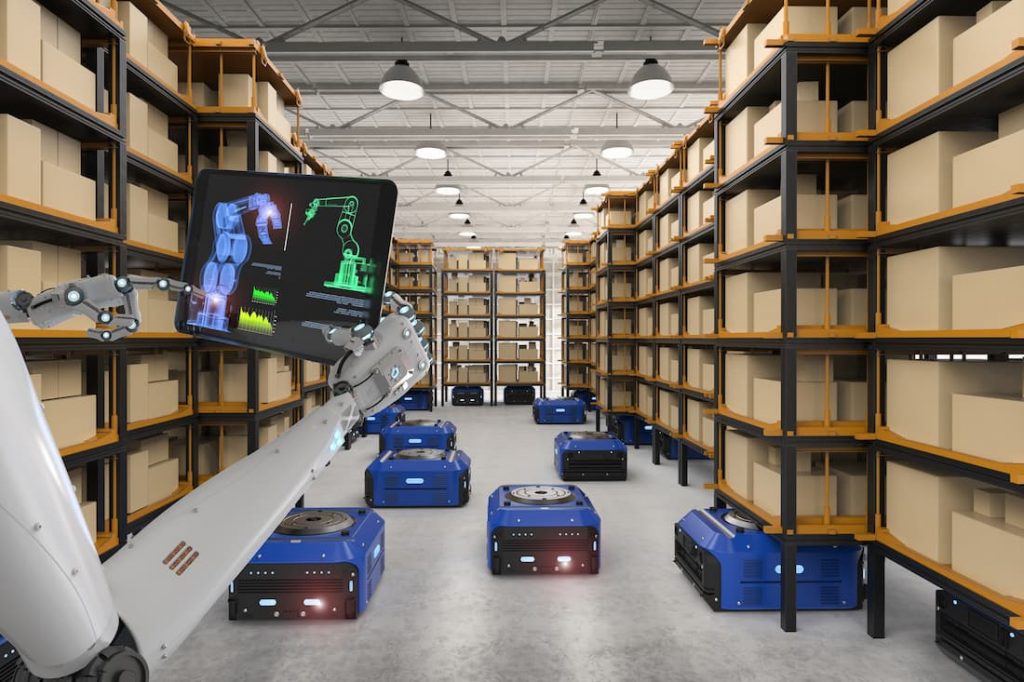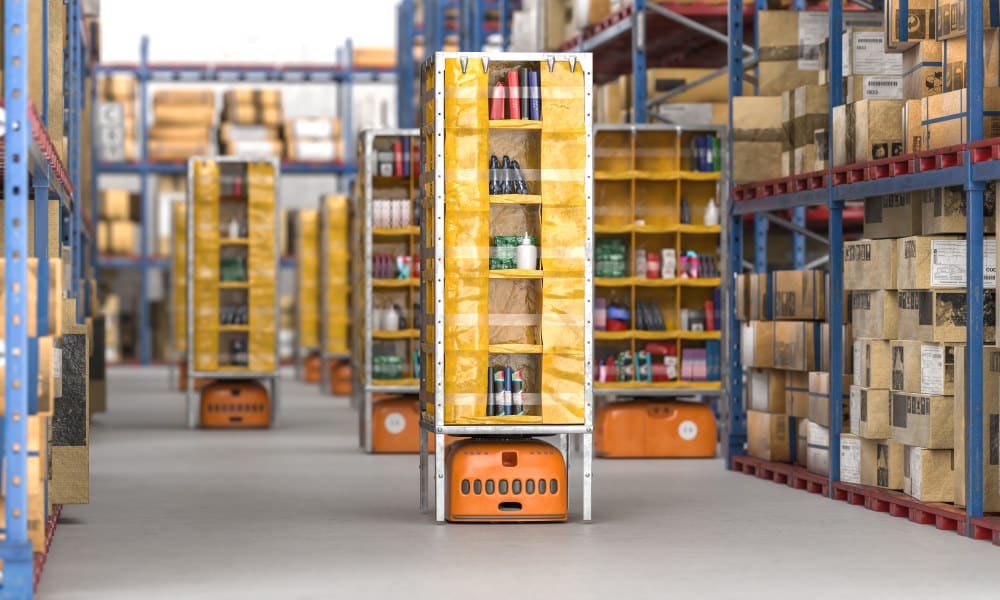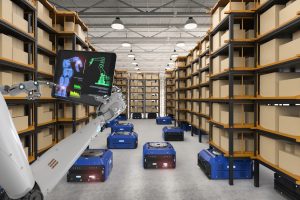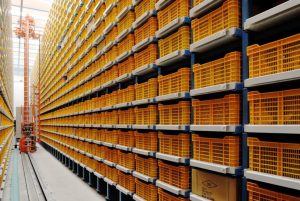As part of our Warehouse Automation series Harry Stafford, Consultant at BoxLogic, investigates one of the more common types of AMR (Autonomous Mobile Robot) on the market.
In this post, Harry discusses the standard rack-to-person AMR solution, outlining how it works, where it is used, in addition to the pros and cons of the technology.

Introduction
An AMR is a type of robot that moves autonomously between multiple points using a combination of sensors to interpret its surroundings. The AMR is fed tasks through a control system, typically loading, or unloading a unit. Goods to person (G2P) AMR (Automated mobile robot) solutions fundamentally keep a human operative in one location for both picking and replenishment while the AMR’s move goods to the stationary operative for each function.

Solution Equipment
AMR Rack-to-Person solutions comprise of a few pieces of hardware and software:
Equipment | Description |
|---|---|
Racks or MSUs | Also known as Mobile Shelving Units (MSU), can hold a wide variety of storage configurations including pick bins for large and small units, pallets and even hanging rails. Racks are typically reach a maximum height of 1.8m allowing an operative to access the goods efficiently. Racks with storage bins have two faces. |
AMRs | AMRs are the element of the solution that performs the storage and retrieval function, making it a rack-to-person (G2P) solution. The AMR can come in a variety of sizes and load bearing capacities, but all ultimately have a clearance of less than 600mm to access the space under an MSU, where it lifts the whole rack and drives it to a storage location or a workstation. |
Workstations | Rack-to-person workstations are where human operatives interact with the system, placing items into pick bins or rails on the MSU or loading a full pallet to the MSU. These same items will be removed from the totes to fulfil customer orders and the workstations can be customised according to the end-user requirements. Most have a put wall of customer order slots to place items into. |
Control System | A control system is the brains and intelligence behind any AMR solution, managing the order well and robots to maximise efficiency. The control system communicates with each AMR to advise of traffic so other AMRs can take alternative routes. It connects to the warehouse management system to receive and confirm customer orders as well as inventory holding. |
Chargers | Chargers are installed in the solution to charge the batteries within the AMRs. The AMRs can be set rules to charge at certain levels or opportunity charge when they are not busy. They are key to maintaining uptime of the solution. |
How do Rack-to-Person AMRs Work?
A typical rack-to-person AMR solution works as follows:
Decant
Goods are injected into the system via the workstations, where a human operative empties replenishment cartons into the storage locations on the presented rack. For operations where full pallets are loaded onto the rack, a pallet stacker truck is required to perform the lift. The operative interacts with a terminal at the workstation to scan products, providing traceability to the control system of which items are on each rack and rack location.
Putaway
The AMR conducts a putaway process whereby it lifts the full rack and takes it to empty storage locations, as directed by the control system and QR codes on the floor to support navigation. Most control systems use the concept of ABC analysis to create hot and cold zones, where faster moving SKUs are located closer to the workstations. This is constantly optimising the slotting to minimise the number of racks requiring movement. Many SKUs might be located across multiple racks to aid throughput.
Retrieval
The AMR will then retrieve the next MSU required as part of the picking process. The AMR travels to the appropriate location, lifting the MSU to the required pick station. There is a buffer zone in front of the workstations that hold several racks to keep the workstations fed with work.
Picking
The picker will be presented with a storage rack by an AMR at the workstation. They will interact with a computer terminal and lights that directs them to the required storage location, SKU and pick quantity, where the item(s) will then be placed in an order container, commonly in a put wall.
The configuration and number of orders in the put wall is customised for each operation. One rack presentation may satisfy multiple pick lines over multiple orders, where one SKU might be required across multiple orders or multiple SKUs on the same rack might satisfy one or more orders. Completed orders will be cleared from the put wall and directed towards packing or marshalling.

Where Can Rack-to-Person AMRs Be Used?
Rack-to-person AMR solutions can be used in a wide variety of sectors and industries so long as items can be stored on MSUs. They are most commonly used in eCommerce environments as they can store a significant number of SKUs and formats of products, allowing easier order consolidation of hanging and non-hanging or toteable and non-toteable products.
Rack-to-person AMRs can be used in almost any building due to its low operating height and its non-stringent floor requirements. It can also be used on a mezzanine, but the decking needs to be coated with a specialist resin to protect the floor from onerous wear.
Pros and Cons of Rack-to-Person AMRs
As with other AMR solutions, it is highly scalable as additional AMR’s and MSUs can easily be added to increase storage and/or throughput in a modular way. This technology is also low capex in comparison to many other solutions, allowing the benefits of automation and robotics to reach a wider set of businesses than ever before.
The main drawback of rack-to-person AMR solutions is it is not a particularly dense storage solution when considering the clear height of a building. As a result, it can be quite a footprint intensive solution, favouring other solutions in taller buildings. Mezzanines can be built to overcome this downside, however, the expense of building the mezzanines can negate the cost benefits of this solution, relative to others.
Comparable Technologies
Businesses considering rack-to-person technology might also consider Carton Transfer Unit AMRs (for buildings with greater clear heights), cube or hive solutions (for buildings with higher clear heights), vertical lifts (for lower throughput operations) and mini-load or shuttle solutions (for much greater clear heights and throughputs).
Summary
BoxLogic have a wealth of experience in warehouse design projects for a variety of cross-sector clients. From identifying suitable types of automation, analysing expected benefits and ROI timescales, through to shortlisting and suggesting vendors. Our independence means that we identify the most appropriate solution for you. If there is no case for automation, we will recommend a manual solution and help you design it.
BoxLogic is well positioned to assist you with your next Warehouse Automation project. Contact us to discuss your project today.



